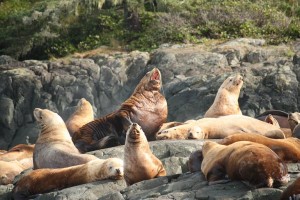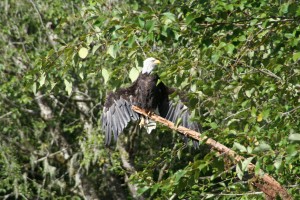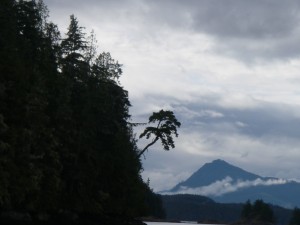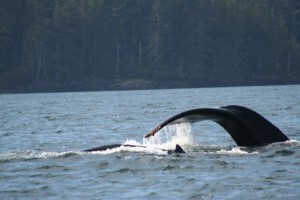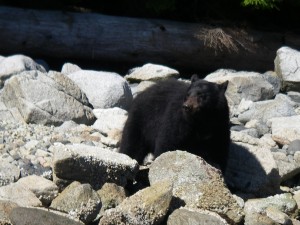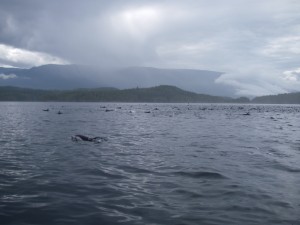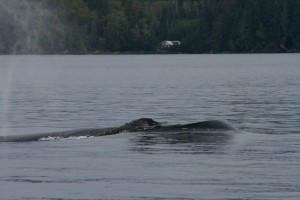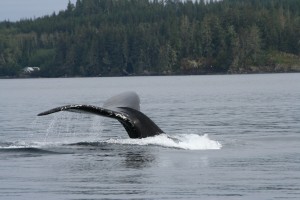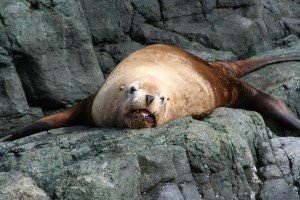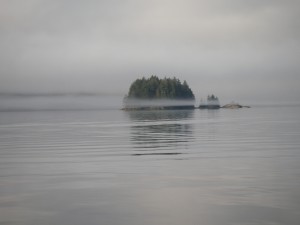Whale Watching
We’re not all about the bears, whales are abundant here too!
Killer whales and humpback whales are often seen during our wildlife tours. There are resident whales and transient whales that can be seen feeding and playing in our waters.
Humpback whale fluke
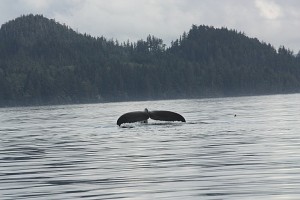
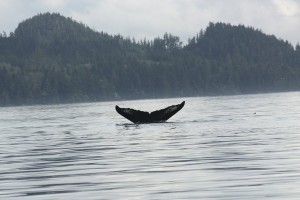 Lynn Morris from the UK provides these photos showing a humpback whale diving and showing the underside of it’s tail. The unique pattern on the tail is used to identify individual whales the same as the dorsal fin and saddle patch is used to identify the orca. The lodge’s whale watching safari area of Bold Head in Blackfish Sound normally contains eight or ten humpback whales, which feed on the herring in the area. The same herring attract the salmon, which in turn are the main attraction for the orca. It is not uncommon to be watching orca and whales at the same time, remembering these are the resident or salmon eating orca.
Lynn Morris from the UK provides these photos showing a humpback whale diving and showing the underside of it’s tail. The unique pattern on the tail is used to identify individual whales the same as the dorsal fin and saddle patch is used to identify the orca. The lodge’s whale watching safari area of Bold Head in Blackfish Sound normally contains eight or ten humpback whales, which feed on the herring in the area. The same herring attract the salmon, which in turn are the main attraction for the orca. It is not uncommon to be watching orca and whales at the same time, remembering these are the resident or salmon eating orca.
Bald eagle sunning after a rain
Even eagles need to get dry. On the lodge’s wilderness tours it is not uncommon to see bald eagle with their wings spread either enjoying the sun or drying after a rain shower. Glen’s photo also shows a pretty good balancing act if you look closely this eagle is standing on one foot while spreading it’s wings. Not the average bird show.
Trees of interest
Almost anything and everything will be of interest to guests. One of my first comments to guest in the boat is that if your want to stop, slow down or go in any direction for a photograph please let me know. We do not run on a tight schedule about the only guideline is to be back to the lodge for dinner as a result there are always interesting photos. Some guests have an interest in birds and some in the variety of scenery some even lake pictures of the bears.
Humpback whale calf
Over the past five years humpback whales have become summer residents in the area we travel to look for killer whales (orca). The area of Johnstone Strait especially around Bold Head in Blackfish sound has become the summer home of humpback whales and their calves. It is common to view between eight and twelve whales on each trip from the lodge. The whale watching safari’s normally see orca, humpback whales, minke whales, sea lions, harbour seals, dolphins, harbour porpoise, dall’s porpoise, eagles and the occasional black bear.
Black Bear on the beach
Your first evening at Grizzly Bear Lodge involves an evening boat run in the local waters looking for black bears. At low tides the bears come to the beach to roll rocks for protein in the form of small crab, clams, barnacles, amphipods and other tiny invertebrates. Guest often ask how do the bears know when there will be a low tide? When we travel along the shore by boat it is possible to pick up the smell of the beach and it is said that bears are thought to have the best sense of smell of any animal on earth. For example, the average dog’s sense of smell is 100 times better than humans. A bloodhound’s is 300 times better. A bear’s sense of smell is 7 times better than a bloodhound’s or 2,100 times better than a human. Simply stated they smell low tide and food.
Pacific white-sided dolphins
Whether on a whale watching safari to Johnstone Strait, grizzly bear trip up Knight Inlet or on the way to Trapper Rick’s on the Kakweikan River there is a chance to play with dolphins. Dolphins are spending their summers in our viewing area and at time in pods of several hundreds. They tend to be very active and to not shy away from boats in fact if you want to be left alone it is necessary to stop the boat and wait until they pass on to another area.
Humpback Whale diving
